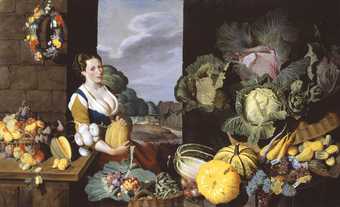Artist biography
Bacon has been called 'the most accomplished English amateur painter of the century' (Oliver Millar in Gervase Jackson-Stops 1985). He came from a distinguished family. His grandfather Sir Nicholas was Lord Keeper under Queen Elizabeth; the politician and philosopher Sir Francis Bacon was also a relation. In 1614 Sir Nathaniel married Jane Meautys of Brome in Suffolk, the wealthy widow of Sir William Cornwallis, and a Lady of the Bedchamber to James I's queen, Anne of Denmark. Jane was a close friend of the art patron Lucy Harington, Countess of Bedford.
Bacon passed much of his time on his East Anglian estates at Culford and Brome. Netherlandish influences are evident in his work, and he is known to have made a 1613 visit to the Low Countries. Fewer than a dozen extant works are attributable to Bacon; however, it is certain he produced others. The inventory with his wife's will refers to 'Ten Great peeces' by the artist, and the diarist George Vertue also mentions several works which are now lost. Bacon painted mainly for his own family, and many of his surviving works are self-portraits. The most significant of these, painted c.1618-20 (Coll. Earl of Verulam, Gorhambury, Herts) shows the artist in his study with various accessories relating to his accomplishments and interests, including an atlas open at Northern Europe, books, a palette and a drawing. Although not highly influential as an artist, he carried out important experiments with varnishes and pigments. His 'Pinke' (a yellowish pigment) was so highly considered by the miniature painter Peter Oliver that the latter 'used none other to his dyeing day' (Edward Norgate, Miniatura, ed. M. Hardie, Oxford 1919, p.14).
Bacon was created a Knight of the Bath early in 1626, on the coronation of Charles I. He died at an early age, probably from tuberculosis, and was buried at Culford. The inscription on his monument describes him as 'well skilled in the history of plants, and in delineating them with his pencil'.
Further reading:
Mary Edmond, 'Bury St Edmunds: A Seventeenth-Century
Art Centre', Walpole Society, LIII, London 1989, pp.106-8
Karen Hearn (ed.), Dynasties: Painting in Tudor and Jacobean England 1530-1630, exhibition catalogue, Tate Gallery 1995, pp.166, 220-23
Oliver Millar in Gervase
Jackson-Stops (ed.), The Treasure Houses of Britain, exhibition catalogue, National Gallery of Art, Washington, DC 1985, p.140
Jane Turner (ed.), The Dictionary of Art, London and New York 1996, III, p.31
Terry Riggs
October
1997
Wikipedia entry
Sir Nathaniel Bacon, (1585 – 1627) was an English painter, landowner and horticulturist from Culford, Suffolk.
This biography is from Wikipedia under an Attribution-ShareAlike Creative Commons License. Spotted a problem? Let us know.
Read full Wikipedia entry

